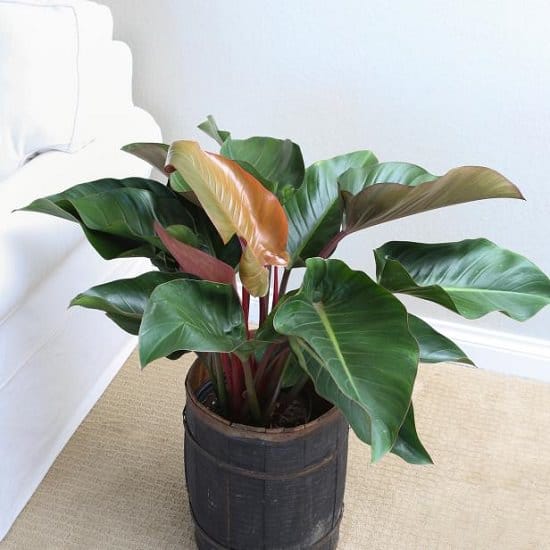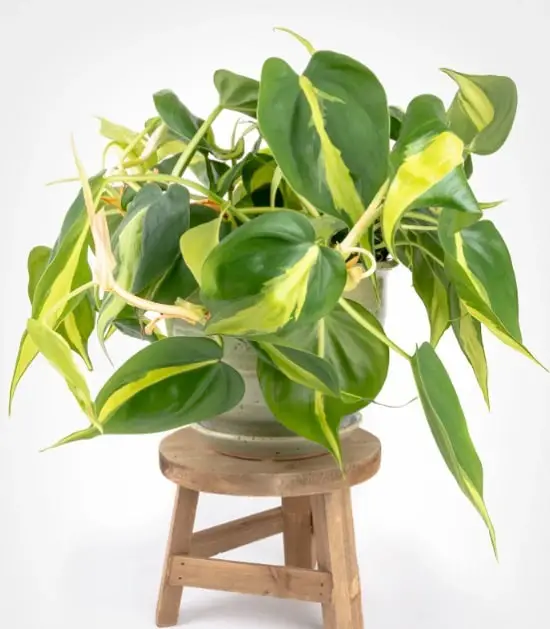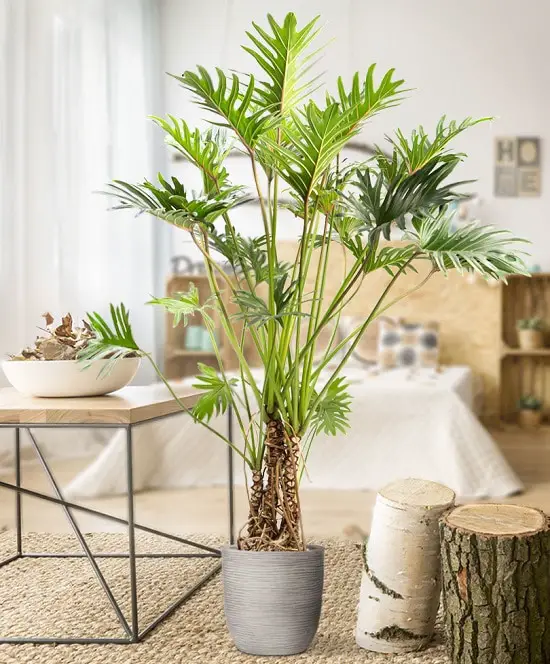Philodendron Plant Care and growing indoors is not that difficult if you know the requirements. Learn everything in detail in this article!

Philodendrons are native to the regions of America and the West Indies. They appeal to the gardeners and homemakers alike, thanks to their shiny, dark green, and attractive foliage! Many exotic varieties bring a certain tropical feel indoors. So, if you too are planning to grow philodendron indoors, here is everything you need to know about philodendron plant care!
Philodendron Propagation
These plants are mainly categorized into two categories: Vining and Non-vining. Vining varieties need support, or they trail down like pothos. ‘Blushing’ and ‘Heartleaf’ philodendrons come under this. Non-vining varieties like ‘Lacy tree’ and ‘Bird’s nest’ have an upright growing pattern and don’t need any support to grow.
Philodendrons can easily be propagated from stem cuttings, especially the climbing ones. You need to place the cutting in a glass of clean water. Once a good network of roots is established, the cutting is ready for planting in a pot. Or, propagate your cutting in soil, following the usual way.
Non-climbing ones can also be propagated from plantlets (pups). Make sure that plantlets are of proper size before you pot them. If you are thinking about sowing seeds, then it might not be a good idea, as philodendron scarcely produces flowers and seeds indoors.
Which Philodendron Variety Should You Grow?

It depends on what suits you because there are 400 philodendron species, and many of them are popular houseplants. Some of the best varieties that you can grow are — Brasil, Brandi, Micans, Green Heartleaf, Mini Split-Leaf, Moonlight, Prince of Orange, Pink Princess, and Rojo Congo.
To know about some of the best philodendron varieties, click here
Choosing a Pot
Choosing a pot size is determined by the philodendron type you’re growing. Start a small plant in a 6 inches pot, repot it when it outgrows the current container. Large varieties like the tree philodendron need a bigger pot. Heartleaf philodendron can be grown in hanging baskets and window boxes.
Tip: When you are repotting an old philodendron plant, select a pot that is at least one size bigger than the previous one.
Also Read: Calathea Care Indoors
Requirements for Growing Philodendron
The secret of growing philodendrons indoors easily is hidden in their natural habitat. They grow naturally in humid tropical forests under a dense canopy of trees, in humus-rich moist soil, getting indirect light, having warm temperature, and humid surroundings. That’s what they want: Indirect light (a couple of hours of direct sunlight is fine), rich loamy soil, slight moisture, and humidity if possible.
Location
All it asks for is bright, indirect sunlight to remain happy and growing. Place it near a window or door where it can receive indirect light. Yellow burning leaves that crackle is an indication of too much light. On the other hand, long and leggy stems indicate that the plant is not getting enough sun. Watch out for these signs and relocate the plant accordingly. This is an important point to consider in philodendron plant care.
Soil
The potting mix you use for other houseplants like pothos should be fine. The soil should be light, porous, loose, and rich in organic matter. To introduce the organic matter, incorporate compost or rotten leaves in the soil. Adding coconut fibers or coco peat in the soil is also beneficial.
Watering
Outdoors, philodendron loves moist soil. But when grown in a pot indoors, overly moist soil can cause root rot, which is why it’s better to keep the soil mildly moist and water only when you see the topsoil is slightly dry.
It’s just a matter of practice–you can start observing the moisture level of the soil by poking your index finger about an inch deep into the pot. If you feel dryness, water thoroughly until the excess water starts dripping from the bottom holes.
Temperature and Humidity
Try to keep the temperature above 55 F (12 C). Below this range, the philodendron plant starts to appear sick. Keep the surrounding humid by placing a humidifier near it or follow these practices here to raise the humidity levels.
Philodendron Plant Care
Some of the Philodendron varieties like ‘Lacy tree’ and ‘Xanadu’ develop pups over time that can crowd up the container, which hampers the growth of the mother plant. Keep removing these pups regularly. Plant them separately for more philodendron plants or discard them.
Pruning

You can prune philodendron to control its length and size to rejuvenate growth. Use a sharp pair of scissors or pruner, snip off the deformed or discolored leaves from the stem. Trim the old or overgrown stems too if you don’t want them to grow bigger. You can always use the cuttings to propagate more philodendron plants.
Fertilizer
Slow growth and small leaves indicate that the plant is not getting enough nutrients and needs fertilization. You can feed the plant monthly, especially during springs and summers. Feed the plant once in 6-8 weeks in fall (autumn) and avoid fertilizing in winter. If you live in USDA Zones 10, 11, or any other frost-free region around the world, you can feed moderately in winters as well.
Go for any balanced liquid fertilizer like 10-10-10 or 20-20-20. The deficiency of calcium and magnesium turns the new leaves pale. In such cases, feed the plant with a fertilizer rich in micronutrients. Occasional application of Epsom salt also helps philodendron.
Tip: Though the plant rarely blossoms indoors, you can use 15-30-15 fertilizer to encourage flowering.
Pests and Diseases
There are no known diseases of philodendron. However, you have to be careful of pests like Spider Mites, Mealybugs, Scale Insects, and Thrips. You can get rid of them by using insecticidal soap.
Is Philodendron Toxic?

Philodendron leaves and stems contain calcium oxalate, which can be toxic to humans and pets if ingested. The crystals can irritate the gastrointestinal area and the mouth. Cats and dogs may feel drooling, loss of appetite, and vomiting. If consumed by humans, it may result in the burning of the mouth and throat, diarrhea, vomiting, blistering, and nausea. However, these symptoms always remain mild and subside on their own.




Our plant is 41 years old !